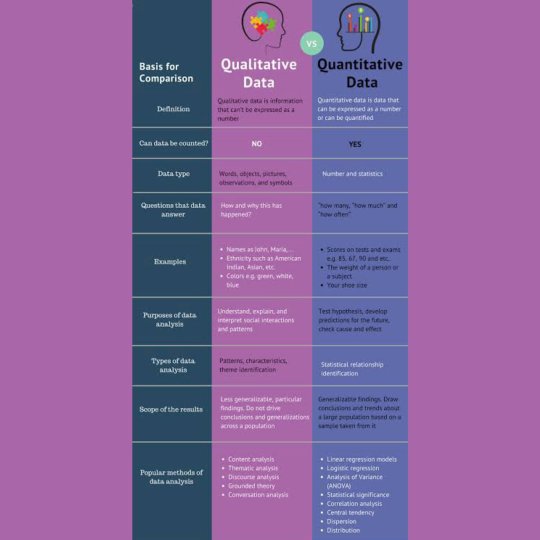#qualitative data
Text
Leveraging the Power of Qualitative Data in Primary Market Research
Introduction
In the realm of market research, data is king. However, while quantitative data often takes the spotlight, qualitative data is equally indispensable. Qualitative research methods offer valuable insights into consumers’ thoughts, feelings, and behaviors, providing depth and context to quantitative findings. In this comprehensive guide, we’ll explore the significance of qualitative data in primary market research and delve into various qualitative research methods that can enrich your understanding of target markets and consumer behavior.
Understanding Qualitative Data
Qualitative data provides rich, nuanced information that quantitative data alone cannot capture. It focuses on exploring attitudes, opinions, motivations, and perceptions through non-numeric data such as words, images, and observations. Unlike quantitative data, which aims for statistical generalization, qualitative data aims for in-depth understanding and often involves smaller sample sizes.
Importance of Qualitative Data in Primary Market Research
Uncovering Consumer Insights: Qualitative research methods help uncover underlying motivations, preferences, and pain points that influence consumer behavior. These insights are invaluable for product development, marketing strategies, and brand positioning.
Exploring Complex Phenomena: Some aspects of consumer behavior are complex and nuanced, requiring qualitative methods to explore thoroughly. For example, understanding why consumers prefer one brand over another involves delving into emotions, experiences, and perceptions.
Generating Hypotheses: Qualitative research can generate hypotheses that can be further tested with quantitative methods. It provides a foundation for designing more focused and effective quantitative studies.
Contextualizing Quantitative Data: Quantitative data provides the ‘what’, while qualitative data provides the ‘why’ behind the numbers. Integrating both types of data offers a holistic understanding of consumer behavior and market dynamics.
Types of Qualitative Research Methods
In-depth Interviews: In-depth interviews involve one-on-one conversations between the researcher and the participant. They allow for probing questions and detailed exploration of individual experiences, opinions, and perceptions. In market research, these interviews are often conducted face-to-face, over the phone, or via video conferencing.
Focus Groups: Focus groups bring together a small group of participants (usually 6-10) to discuss specific topics under the guidance of a moderator. They encourage interaction and dialogue among participants, providing insights into shared attitudes, opinions, and group dynamics.
Observational Research: Observational research involves observing participants in their natural environment without direct interaction. This method is particularly useful for understanding behavior in real-life settings, such as retail stores or online platforms.
Ethnographic Studies: Ethnography involves immersing researchers in the culture or context of the target population to observe behavior, rituals, and social interactions firsthand. It provides deep insights into consumer lifestyles, values, and cultural influences.
Content Analysis: Content analysis involves systematically analyzing textual, visual, or audiovisual content to identify themes, patterns, and trends. It is commonly used to analyze social media conversations, customer reviews, and other forms of user-generated content.
Case Studies: Case studies involve in-depth examination of a particular individual, group, or organization. They provide detailed insights into specific scenarios or phenomena and can be particularly useful for understanding complex or unique situations.
Best Practices for Conducting Qualitative Research
Define Clear Objectives: Clearly define the research objectives and the information you seek to gather through qualitative methods.
Select the Right Method: Choose the most appropriate qualitative method based on your research objectives, target audience, and resources.
Develop Discussion Guides: For interviews and focus groups, develop discussion guides to ensure consistency and cover all relevant topics.
Ensure Participant Comfort: Create a comfortable and non-threatening environment for participants to encourage open and honest responses.
Analyze Data Thoroughly: Use systematic approaches to analyze qualitative data, such as thematic analysis or coding, to identify patterns and insights.
Triangulate with Quantitative Data: Combine qualitative findings with quantitative data to validate findings and provide a comprehensive understanding of the research topic.
Conclusion
Qualitative research methods play a crucial role in primary market research, offering deeper insights into consumer behavior, preferences, and motivations. By leveraging the power of qualitative data alongside quantitative data, businesses can make more informed decisions, develop targeted marketing strategies, and create products and services that resonate with their target audience. Understanding the various qualitative research methods and implementing best practices can unlock valuable insights that drive business success in today’s competitive market landscape.
FAQs
1. What is qualitative data in market research?
Qualitative data in market research refers to non-numeric information that explores attitudes, opinions, motivations, and perceptions of consumers. It provides depth and context to quantitative findings and helps understand the ‘why’ behind consumer behavior.
2. Why is qualitative data important in primary market research?
Qualitative data is important because it uncovers consumer insights, explores complex phenomena, generates hypotheses, and contextualizes quantitative data. It provides a deeper understanding of consumer behavior and market dynamics, leading to more informed decision-making.
3. What are some common types of qualitative research methods?
Common types of qualitative research methods include:
In-depth Interviews
Focus Groups
Observational Research
Ethnographic Studies
Content Analysis
Case Studies
4. How do I choose the right qualitative research method for my study?
When choosing a qualitative research method, consider your research objectives, target audience, and resources available. Select the method that best aligns with your goals and allows for in-depth exploration of the topic.
5. How can I ensure the success of my qualitative research study?
To ensure the success of your qualitative research study, follow these best practices:
Define clear objectives
Select the right method
Develop discussion guides
Ensure participant comfort
Analyze data thoroughly
Triangulate with quantitative data
6. How can qualitative and quantitative data be integrated in market research?
Qualitative and quantitative data can be integrated by combining insights from both types of data. Qualitative data provides depth and context, while quantitative data offers statistical validation. Triangulating the two types of data leads to a comprehensive understanding of the research topic.
7. What are the benefits of conducting ethnographic studies in market research?
Ethnographic studies immerse researchers in the culture or context of the target population, providing deep insights into consumer lifestyles, values, and cultural influences. This method offers a holistic understanding of consumer behavior in real-life settings.
8. Can qualitative research methods be used to study consumer behavior online?
Yes, qualitative research methods can be adapted for studying consumer behavior online. Methods such as online focus groups, social media analysis, and content analysis of user-generated content can provide valuable insights into online consumer behavior and preferences.
#primary market research#qualitative research#qualitative research methods#qualitative data#qualitative data in primary research
0 notes
Text

Qualitative research is a sophisticated methodology that explores the complexities of people's attitudes, motivations, and actions. Qualitative research provides rich contextual insights that are not possible to obtain from quantitative data alone. Methods that are used to achieve this include focus groups, interviews, and observations. It provides a thorough grasp of individuals or groups by examining the underlying causes of behaviours and perceptions. Businesses can ensure alignment with the needs and preferences of their target audience by making informed decisions regarding product development, marketing strategies, and organisational improvements thanks to this depth of understanding.
Contact us to know more about it.
Visit- https://snwareresearch.com/contact/
#qualitative research#qualitative analysis#qualitative data#quantitative research#market research#research services#focus group#online panels#market insights
0 notes
Text
User Insights in a UX Audit: Comparing Quantitative and Qualitative Data
User Experience (UX) audits are an essential component of every company's digital product and service improvement strategy. Organizations can find areas for development, growth potential, and pain issues by using these audits. One of the most important choices you'll have to make during a UX audit is whether to prioritize qualitative, quantitative, or a combination of the two forms of data.
In this blog article, we'll go over the importance of both quantitative and qualitative data as well as how to combine the two for a comprehensive UX audit.
Quantitative Data in UX Audits
Any information that can be quantified and expressed numerically is considered quantitative data in a UX audit. Included are often key performance indicators (KPIs) and extra statistics, such as click-through, bounce, and conversion rates. Certain statistics are needed in order to comprehend the overall health and efficacy of a digital good or service. The use of quantitative data in UX audits is justified by the following:
Clear and impartial analysis of user interactions with a digital product is made possible by quantitative data. These metrics provide a quick and easy method to assess a user interface's efficacy and spot possible problems.
Benchmarking: Quantitative data allows businesses to benchmark their performance against industry standards or competitors. This information can help identify areas where a product or service is lagging behind or excelling.
Identifying Pain Points: Conversion funnels and quantitative data can pinpoint specific bottlenecks or drop-off points in the user journey. By identifying these pain points, businesses can prioritize improvements that have a direct impact on ROI.
A/B Testing: To perform A/B testing, quantitative data is required. Businesses can make data-driven decisions about which options to deploy by evaluating the performance of two or more versions of a design or feature.
Because quantitative data is more accurate and can demonstrate how UX improvements affect revenue, it is frequently preferred. It is imperative for businesses to recognize the importance of these measures in a fiercely competitive industry.

Qualitative Data is Vital for UX Audits
Although quantitative data is very useful, it does not give the complete story. Qualitative data is equally important to statistics as quantitative data since it clarifies the "why" behind the statistics. Surveys, interviews, usability testing results, and user feedback are examples of qualitative data that can be found in a UX audit. The importance of qualitative data is as follows:
User insights: Using qualitative data can help you understand people's opinions on a deeper level. It exposes their goals, inclinations, and vulnerable spots. Gaining this understanding is necessary to enhance user-centered experiences.
Contextual Understanding: The background is supplied by qualitative data. It aids in your comprehension of the particular situations and environments in which users engage with your product. Keeping this structure in mind is essential while creating solutions for real-world issues.
Prioritizing Changes: Although quantitative data helps pinpoint issues, it is unable to explain their root causes. Qualitative data can be used to rate issues according to user discomfort and importance.
Iterative Design: Qualitative data is a crucial component of iterative design. By regularly gathering user feedback, you may make incremental, minor adjustments to your product or service that will guarantee it adjusts to the needs of changing users.
In a business environment, where customer relationships and long-term value are paramount, qualitative data plays a critical role in understanding the unique challenges and needs of clients. This information can drive product development and UX improvements that directly impact client satisfaction and retention.
Balance in UX Audit
Instead of having to choose between qualitative and quantitative data, businesses must find the right balance between the two. Here are a few strategies for achieving that balance:
Specific Objective in Mind: Clearly define the aim and purpose of your audit. Are you trying to increase conversions, decrease the amount of calls you receive from clients, or increase user satisfaction? How you collect data will depend on your goals.
Combining Data Sources: Utilize data that is both quantitative and qualitative. For example, include user feedback from surveys and interviews with quantitative data from analytics programs like Google Analytics.
Triangulation: Look for patterns and connections in the quantitative and qualitative data you have collected. In your conversion funnels, where do you see drop-off points in relation to user suggestions or complaints? This triangulation may help you pinpoint significant issues.
Iterate and repeat: The process of UX auditing is never-ending. Continue gathering and analyzing data, modifying as needed in light of your conclusions. This iterative process makes sure that your UX enhancements continue to be in line with both user needs and corporate objectives.
Engage Stakeholders: Work together with stakeholders from various departments inside your company. These consist of groups that handle product development, marketing, sales, and customer service. Their perspectives can help prioritize UX improvements and offer insightful context.
Test and Validate: Make sure functionality and designs are tested and confirmed with real users before making any changes based on your data. The efficacy of your UX enhancements can be verified using qualitative data from user testing.
Note for conclusions: Pay attention to the findings and insights that the quantitative and qualitative data provide. This documentation might end up being a very useful tool for auditing and decision-making in the future.
To find out everything there is to know about the UX audit, visit the Techved website.
Conclusion
Combining quantitative and qualitative data in UX audits is key to driving changes in products and services that will improve customer experiences and increase return on investment. Quantitative data gives the framework for measurement, but qualitative data provides the context and insights needed for meaningful change.
It is not only feasible, but necessary to strike the right balance between these two types of data if you want your business to prosper. By implementing the aforementioned tactics and utilizing an iterative process, you can ensure that your user experience audits result in continuous improvement, higher customer satisfaction, and a competitive advantage in the market.
0 notes
Text
Qualitative Data vs. Quantitative Data
Qualitative Data vs. Quantitative Data

View On WordPress
0 notes
Text
this genre of seb quotes and covering his mouth w his hand and, in ciel's own words, "giggling":







#off my commie posts to say this!!!!!#he's off his marxism to do some primary research on ciel's preferences#the kind of qualitative data we all need#chapter and volume in the alt text !!#sebaciel#kuroshitsuji#symuses#sebastian x ciel#ciel x sebastian
73 notes
·
View notes
Text
A fun exercise for the reader on that last post around why outsiders aren't often university presidents; academic presidents are *better fundraisers* on average than outside business leaders. Why is that so?
8 notes
·
View notes
Text
all of my research interviews this week have been soooooo juicy i can’t wait to analyse them
#every time i do qualitative research i go through a phase of i’m not gonna have enough relevant data!!!!!!!#and then i revise the qs and it changes everything#adventures in academia
11 notes
·
View notes
Text
I just spent the past week reading a whole book that was on part about like triangulating quantitative with qualitative data and that you really can't draw a whole lot of conclusions from quantitative data alone esp when there's the question of how did the people interpret the questions, what motivated them to act the way they did what are other intersecting identities. But that being said this is just interesting.
4 notes
·
View notes
Text
Another day trying to convince my fellow biologists of the value of adding a single, complete English sentence to their list of field measurements and raw observations. To pull everything together. To state their conclusion, even
#Tbh it's exciting the crew has been crushing the basics so well we are at this point#But I was literally asked ''what are the upstream comments even used for'' yesterday#To give context? To provide a narrative a human easily read and process? To make your conclusions and supporting evidence clear?!#The data that's numbers is valuable for sure but so are the words!!!#Anyway once I recovered from the shock I think I did ok articulating the use#Why do we have qualitative data good lord#STEM bro ass question
3 notes
·
View notes
Text
no one in my family reps my humanities degree 😞
#me: I’m doing an MSc next year#them: they’re calling silly humanities a SCIENCE NOW?? this is everything wrong with society#me with r studio open making multivariate linear regression analyses from qualitative data: ….#*quantitative data even LOL#AAAAAA#and bc I went to American high school I have AP biology I did honours Chem in final year I did calculus#just. and almost all my friends have stem degrees and I can talk to them abt their degree content#I read medical journals usually psychology/psychiatry for fun like it’s sooooo#and my dad works in medical research and alwsys offloads all the technicalities of that industry to me#just so frustrating not being taken seriously 😭#I have THEE most competitive humanities degree to get into from the best humanities uni in the country and theure like nah fake degree
4 notes
·
View notes
Text
i really should do something with all the info i collated regarding disability in dta. someone compel me to please
#i was thinking some kind of essay#summarising the different perspectives#mainly because i don’t remember how to summarise qualitative data#in a more formal or organised way#where’s a dude who’s not really a dude who loves a spreadsheet when you need him#down to agincourt
16 notes
·
View notes
Text
Answering Tumblr polls makes me feel like I'm taking part in important sociological research.
3 notes
·
View notes
Text
going to need brisbane to be a lot faster than sydney about putting up ritual clips on youtube. tsk tsk. what do you mean there's nothing [checks watch] like three hours after the show ended.
#i absolutely Refuse to react to any posts. or ANY takes. about what goes down in brisbane until i can look at the clip myself.#i literally do not trust the way people use adjectives on this website. to describe his actions and him.#i can't accept qualitative data about copia on here i need to witness it.
4 notes
·
View notes
Text
An y’all tag legitimate research studies (multiple) when making some of your claims because it’s 2023 and blindly taking people at their word with no kind of evidence to back it up beyond subjective opinion is very TikTok
#sorry just#the neurodivergent psych here who needs data and evidence and while personal experience is valid as narriative and qualitative data#imma need more than that
3 notes
·
View notes
Text
Precision Insights: Expert Quantitative Market Research Services
Our Quantitative Market Research Services help you quickly gather insights from our panellists and understand the changing consumer behaviour. Using our comprehensive services, we find the answers to the most of your questions! Follow this link to know more https://insighttellers.com/services/quantitative-research-market

#Quantitative Market Research Services#Qualitative Research#Translation#Survey Programming#Data Collection & Analysis#Secondary Research#Panel Aggregation#Contracted Work
2 notes
·
View notes
Text
EXAMS DONEEEE this last paper was so crazy like there was a 30 marker on globalisation which I did unfortunately predict because I said if it's on globalisation state crime and green crime I will kms and it was so now I have to do it. however I also did predict the feminist theory 20 marker so I don't have to kms bc that was a blessing
#crime questions were so weird there was one on surveillance one on punishment ??? then social class offending which was fine#then the 30 marker on globalisation oh my GOD#the theory section was beautiful it was feminist theory and qualitative data. perfect
2 notes
·
View notes